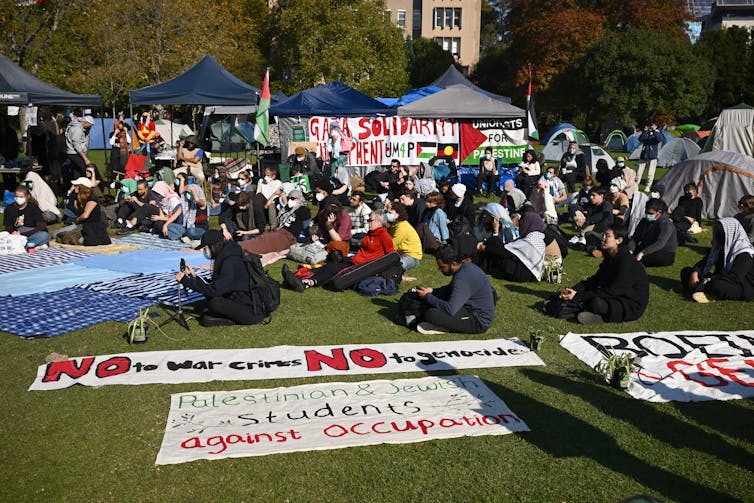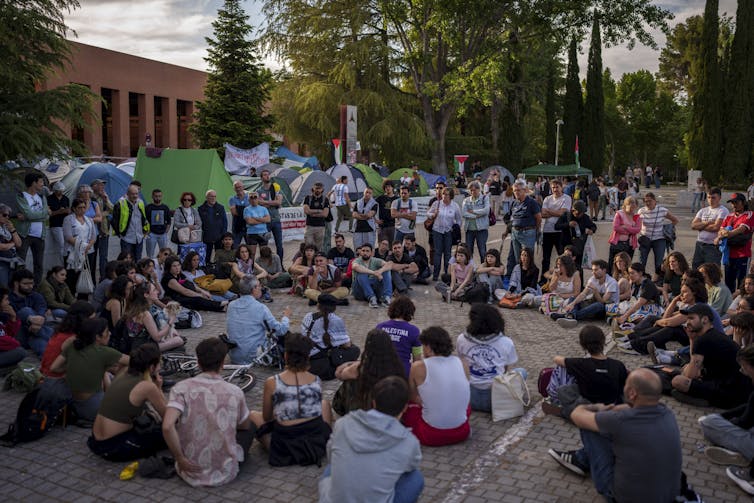University campuses around the world have become the site of tiny tent cities in recent weeks, with student activists protesting the ongoing conflict in Gaza.
Though the protests on Australian campuses have been largely peaceful, tensions are starting to rise. There have been allegations of hate speech and clashes between student groups in recent days. And in the US, there have been disturbing scenes of police interventions to break up similar protests nationwide.
The students, and many others, are protesting the loss of life and worsening conditions in the current Gaza conflict. Many Israeli hostages taken in last year’s assault by Hamas have yet to be returned, while the Palestinian death toll from the Israel Defence Forces’ response is believed to have exceeded 34,000. Many Palestinians are also experiencing what the United Nations has termed a “full-blown famine”.
The situation in Gaza is undoubtedly severe and requires urgent international attention and a peaceful resolution. Yet it is not the only armed conflict or humanitarian crisis in the world – far from it.
Why, then, has the Gaza war generated such passionate and sustained interest, particularly among young people? Why are people motivated to protest on this specific issue, but not others?

A strong narrative that shocks us
There are many factors that explain why people choose to protest. Personal, family or community impacts are strong motivations to become an activist. But even for those without an obvious connection to a cause, news coverage and stories shared to social media can be enough to catalyse action.
Researchers have found some stories or narratives are more effective than others at mobilising political activism. In the case of the Gaza war, I believe three factors in the narrative have helped fuel the significant protest movements we are seeing globally.
First, narratives are powerful motivators of action when they combine elements of what social movements scholars call “breach” and “resonance”.
A crisis narrative, like the one in Gaza, attracts and holds people’s attention because it shocks us. It represents a “breach” with our expectations of how life should be and what we deem acceptable.
A powerful narrative must also be “culturally resonant”, which means it is consistent with our understanding of how the world works. That is to say, it must reflect a familiar story.
The images of children and families who have been harmed by the Gaza war tell a horrific, yet recognisable, tale. And this has motivated protesters to act to try to right the wrong, and correct the breach.

The recognition of an ‘ideal victim’
Second, protesters are often motivated to engage in collective action to defend or protect an “ideal victim”.
While the term “ideal victim” is far from ideal, the concept itself is ever-present in awareness campaigns and protest movements, due to the power of this central figure to compel action. In academic terms, ideal victims are those seen as being innocent and powerless.
Historically, campaigns on behalf of the Palestinian people have not achieved the same support or urgency that we are seeing now. In the current Gaza conflict, the military strength of the Israel Defence Forces, contrasted with the vulnerability of the civilian population in places like Rafah, highlights the “ideal victim” in need of protesters’ urgent actions.
Of course, there are many “ideal victims” in conflicts and crises around the world whose stories are not catalysing collective action.
This is, in part, because their stories are not being showcased through news outlets and on social media. While the “ideal victim” must be recognised as powerless, they must also be able to tell their story to motivate others to act, either themselves or through their advocates. Many victims of conflict are rendered invisible by inattention.
Read more: Divesting university endowments: Easier demanded than done
The ability to have a tangible impact
Third, protest or collective action is often more sustained when there is a clear call to action and activists can see a role for themselves within the narrative.
The “real time” nature and urgency of the Gaza war is an important motivator for action. While the broader Israeli-Palestinian conflict is not new, the current situation has played out in front of our eyes since October, when Israelis were kidnapped and killed in the Hamas assault and the government responded with military force.
With a ground assault on Rafah seemingly now imminent, activists may be motivated by the sense this is a critical juncture in the conflict where their protest may have a real impact.
The motivation to protest also rises exponentially when other types of activism fail to bring change. For example, when political leaders ignore petitions and representations from community groups, protest movements emerge. And when legislatures fail to act, protesters call for action from others.
In the current protests, for instance, many students are calling for their universities to divest from weapons manufacturers profiting from the conflict, or Israeli companies linked more broadly with the occupied West Bank and Gaza, as a symbolic protest.

This is part of the wider boycott, divest and sanction (or BDS) campaign, which uses political consumerism and political investorism as protest tactics.
The conflict in Gaza may seem intractable, but the divestment demand gives protesters an achievable aim with a localised target – their own universities. Protesting at this important time, with an achievable demand, allows activists to write themselves into the narrative. They can contribute something to the push for peace.
In recent days, this action has led to tangible results. Trinity College Dublin in Ireland agreed to divest from three Israeli companies linked to settlements in the occupied Palestinian territories. After the university made the announcement, students began dismantling their protest camp.
Protest is not always about achieving specific demands, though. Protests also have significant symbolic value in raising awareness and bringing others to the cause. Whether student protesters are motivated by powerful stories, a need to protect victims or the chance to have an impact, they exemplify a wider narrative message that protesting for peace is a worthwhile pursuit.

